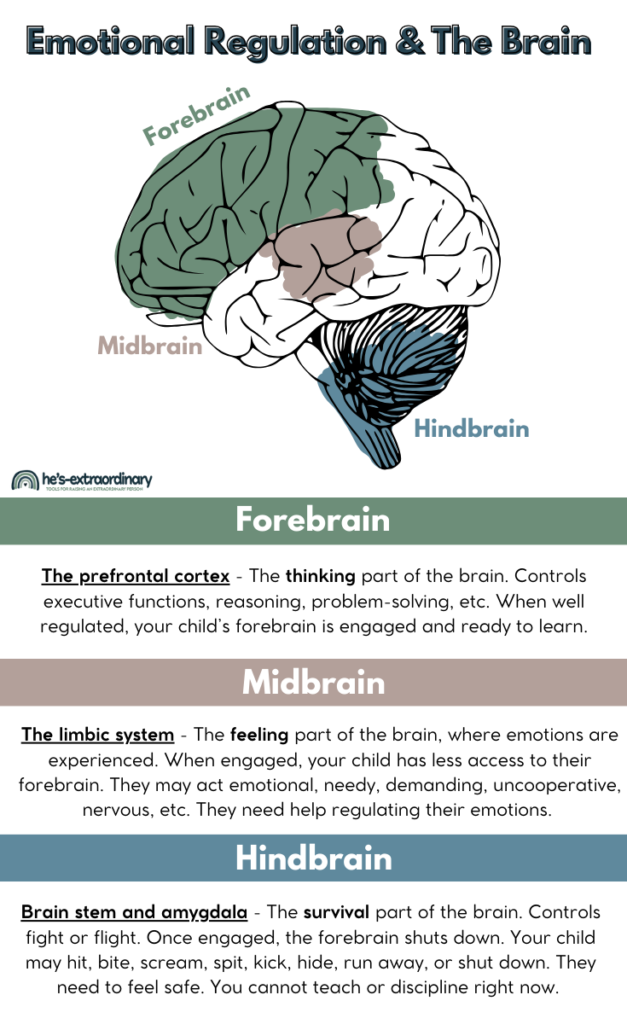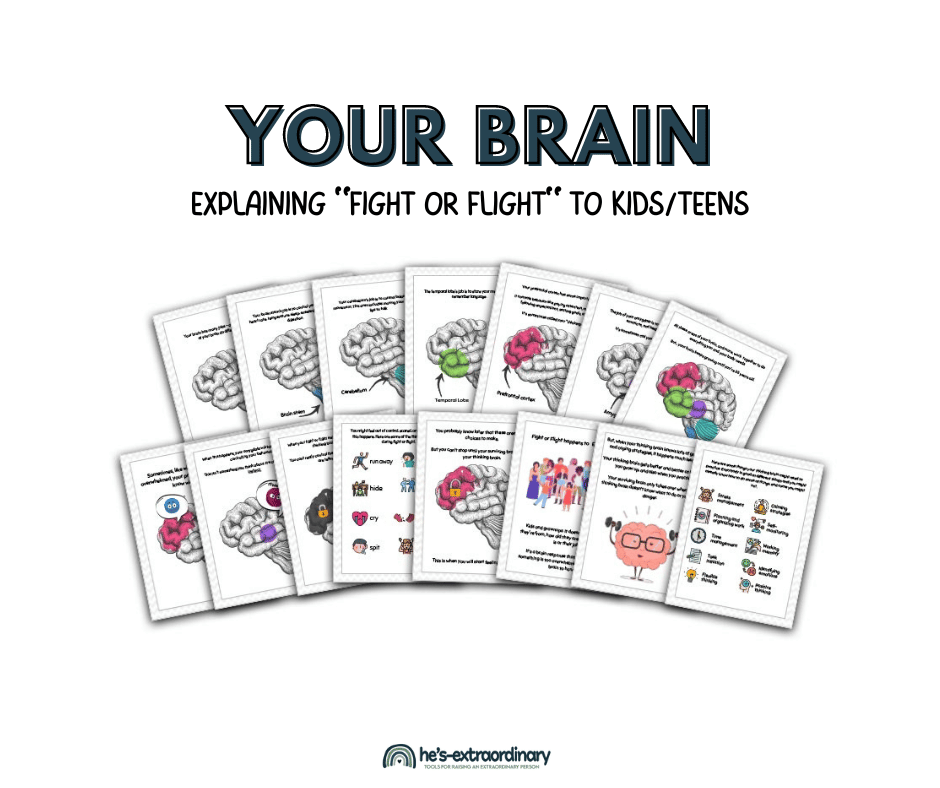How to Keep Calm During Difficult Parenting Moments
What’s inside this article: Helpful tips for parents to help them stay calm and regulate their own emotions during difficult parenting moments when their child’s behavior is triggering to them.
Whether you’re dealing with backtalk or what feels like a never-ending meltdown, knowing how to stay calm (parental regulation) is the most important (and often most difficult) part of handling the situation.
Scientific research shows a strong correlation between a parent’s emotional regulation skills and the child’s abilities to regulate their emotions.
The best way to foster emotional regulation skills and resilience in children is to model those skills yourself.
Your arousal level is also contagious. Staying calm is necessary if you want to de-escalate a situation successfully.
Parental Emotional Regulation
Parental Emotional Regulation refers to a parent’s ability to manage and control their own emotions, especially in the context of interacting with their children. It’s about how parents handle stress, frustration, anger, sadness, and other emotions in ways that don’t negatively impact their children.
Your Child Needs You to Stay Calm
Staying calm is important for many reasons:
- Modeling Behavior: Children often learn by watching their parents. If parents handle their emotions in healthy ways, it helps kids learn to do the same.
- Creating a Safe Environment: Parents who regulate their emotions can provide a more consistent and secure environment for their kids. It can be scary to a child if they don’t know how their parent might react to any given situation.
- Strengthening Relationships: Emotional regulation can lead to better communication and understanding between parents and children. It can reduce conflicts and increase mutual respect.
- Promoting Child Well-being: A parent’s emotional well-being and regulation influences their child’s mental and emotional health. Kids feel more secure and understood in homes where emotions are managed healthily.
In essence, parental emotional regulation isn’t about suppressing feelings, but rather understanding, managing, and expressing them in constructive ways, especially in the presence of children.
It’s a crucial skill for creating a positive and nurturing family environment.
Staying Calm When Your Child Isn’t
Do you have a breaking point as a parent, where you just can’t stay calm anymore?
Maybe your child’s been having a meltdown for the past hour, and you just don’t know what to do. Or, maybe it’s something they say or do when they’re mad that just immediately makes you lose your temper.
Or, 90% of the time, you can handle it, but that 10%, when you’re already tired and having a bad day – you can’t.
How do you stay calm in these moments?

1. Identify Your Triggers
First of all, you need to know what your triggers are.
Keep a list in a notebook or on your phone. Write down any time you struggle to stay regulated. Be as specific as possible. The details definitely count.
Also, keep a list of any behaviors that you aren’t sure how to handle, or aren’t sure if you’re currently handling them in the best way.
This will all help you later.
Here are some examples:
- When your child hits a sibling
- When they’re oppositional and refusing all of your requests even though they had no problem doing these things yesterday
- Breaking and throwing things
- Saying mean things like ” I hate you”
Anything predictable is preventable.
If you know you’re going to be triggered every time your child says they hate you – then you can plan exactly what you’re going to do in these moments instead of freaking out.
Once you’ve got a plan, you’re no longer reacting to your child’s behavior, you’re responding to it.
Know Your Warning Signs
What are the earliest physiological signs that you’re going to flip your lid?
Everyone experiences stress or anger a little differently, but there are a lot of common signs. It’s important to be aware of your signs so you can take action early.
Examples:
- Clenching your fists
- Heart racing
- Face feeling hot
- Tunnel vision
- Headache
- Pacing
- Racing thoughts
- Giving snappy responses to others
- Faster breathing
It’s Understandable
Just so you know – it’s completely understandable that sometimes you can’t stay calm.
It takes an incredible amount of strength to remain level-headed when you may be rushing with emotions like anger, helplessness, fear, hurt, etc. It also makes sense that you feel angry, sad, hurt, etc during high-stress parenting moments.
So all those times that you handle things like a champ – pat yourself on the back. And the times you don’t? Don’t beat yourself up.
You’re doing the best you can.
2. Understand Why Meltdowns and Outbursts Happen
Although when you’re in the moment it may feel like the sole purpose of your child’s behavior is that they want to push your buttons and make you mad – that’s only what’s on the surface.
Children don’t enjoy feeling angry, or out of control.
They become angry and out of control because they don’t have the necessary skills to behave differently, and in times of high stress, it’s an autonomic nervous system response.
Even if you’ve seen them do it a million times – they aren’t able to access that skill at the moment. Just like when you lose your temper in the moment – despite wanting to stay calm.
As Dr. Stuart Ablon explains, kids do well when they can. So if they aren’t doing well, it’s because they can’t.
By the way, parents do well when they can, too.
Changes in the Brain During Meltdowns
It might help you to stay calm if you understand what actually happens to the chemistry of the brain during a meltdown.
A lot of parents are able to see things from a new perspective when they know this information.
Our brain uses different areas of the brain for different things.
Prefrontal Cortex
The prefrontal cortex is the part of the brain we use most of the time. It controls all executive functioning. This includes problem-solving skills, decision-making, emotional regulation, self-control, etc.
This part of the brain isn’t fully developed until the mid-twenties, so it’s not perfect. However, when children are using this part of the brain, they’re generally well-behaved.
Midbrain
The midbrain is the “feeling” part of our brain. It’s emotional.
When this part of the brain is controlling a child’s behavior, they’re in the “yellow zone.”
There’s some loss of control, so you may start seeing inappropriate behaviors.
Your child may be needy or clingy, hyper and distracted, or demanding and uncooperative.
Amygdala
The amygdala is the part of the brain that controls our instincts, such as fight or flight.
When a person feels threatened – whether that threat is real or only perceived – the fight or flight instinct takes over.
The amygdala blocks access to the prefrontal cortex, and we go into “survival mode”
When this happens to your child, they may melt down or shut down. At this time, your child can’t problem-solve. They can’t control their behavior or respond to your reasoning with them.
They’re in “the red zone,” and there is a complete loss of control.


Your Brain: Explaining Fight of Flight to Kids
Subtitle for This Block
15-page, easy-to-understand narrative that helps children and teens understand how their brain works and what the fight or flight instinct is. This tool is useful for psychoeducation.
3. Practice Rational Detachment
Rational detachment is the ability not to take your child’s hostility or behaviors personally so that you can remain in control of your own behavior.
It’s a way of detaching from the situation so your feelings aren’t controlling your reaction. Using rational detachment allows you to take a moment, separate yourself from your immediate feelings, and respond to the situation more calmly and effectively.
The Crisis Prevention Institute teaches rational detachment as a non-violent crisis intervention technique.
Tips for Using Rational Detachment Effectively:
- Recognize the emotion: Before you can detach from it, you need to recognize you’re feeling it. Maybe it’s frustration when your child talks back or feeling overwhelmed as they scream during a meltdown.
- Pause: Before reacting, take a deep breath. This moment of pause is your chance to step back mentally.
- Zoom Out: Imagine you’re watching the situation from above or as if it’s a scene in a movie. This can help put things in perspective and reduce the intensity of your immediate emotions.
- Ask yourself objective questions: “What’s actually happening here? Is it a big deal in the grand scheme of things? What’s the best response for my child’s well-being?”
- Use positive self-talk: Help yourself remain calm with positive self-talk phrases. See examples below.
- Respond calmly: Now that you’ve taken a moment to assess the situation without the cloud of intense emotion, you can decide on the best course of action.
- Practice regularly: The more you practice rational detachment, the easier it becomes. Over time, it can be a natural step in your parenting process.
Self-Talk Statements
These are just a few ideas of things you can say to yourself to help you stay calm. Choose one that resonates with you and use it.
- Don’t take it personally; my child is not in control.
- I may be the target, but that doesn’t mean they feel this way about me.
- It’s not their fault or mine.
- This is temporary, and my child needs me to make them feel safe.
- It’s normal to find this stressful, but I can still control my reaction.
4. Make a Plan
Having a plan can make all the difference regarding how to stay calm.
Without a plan, you’re just living in the moment, reacting to whatever comes your way. You’re using your judgment, which could be affected by your feelings at the moment.
This makes you more susceptible to losing your temper, acting out of impulse, and maybe doing something you regret.
You and your spouse should create and follow the plan together, the consistency will help, over time, with emotional modulation.
I don’t want to give out too much personal information, so I’m not sharing a photo of our plan (it has the kid’s names on it)
However, our family’s plan involves guiding the child to their bedroom. Then, take three deep breaths and use positive self-talk to stay calm before heading up the stairs to their room.
We bring a drink of water with us since that can be a helpful self-regulation strategy for some. Then wait outside their bedroom door and check in every 3-5 minutes until the child is calm enough that we can comfort them.
During this time, we continue to use strategies in the hallway to help us stay calm.
Your plan should be completely unique to you and what works best for your family.
If you want help creating the best plan for dealing with challenging moments, I offer a mini online workshop called meltdown magic. You can learn more about it here.
5. Switch Out, If You Can
I know this isn’t always possible and for some people, it’s never possible.
But, if you can, switch out with your spouse when you are getting overwhelmed.
Rather than trying to handle a tough parenting situation at the same time, work as a tag team. When you tag your partner in, go do something that will help you calm down.
This could be anything that helps you feel better. Take a ten-minute walk around the block, listen to your favorite music, and do a few yoga poses. Whatever helps you relax.
You’ll be able to return feeling more composed and may even have a new outlook on the situation once you’ve stepped away.
6. Calm Your Physiological State
Your mind and body are interconnected. When your mind isn’t calm, neither is your body. Your heart pounds in your chest, you feel hot, you may shake,
Calming down the arousal level of your body can help calm your mind down at the same time.
Deep Breathing
Deep breathing helps you slow your breathing down and slow down your heart rate.
Take long, deep breaths slowly through your nose and exhale through your mouth.
I like square breathing, which is an exercise where you breathe in for four seconds, hold for four seconds, exhale for four seconds, and then hold for four seconds before starting again.
You can get some printable deep-breathing posters here.
These activities are not exclusively for kids. Deep breathing is a great coping strategy for all ages.
Lower Your Temperature
Since being angry can make you feel hot, doing something to lower your temperature can help you calm down.
- Drink of cold water
- Splash cool water on your face from the sink
- Place a cool cloth on the back of your neck
- Chew on ice chips
7. Self-Care
I know it’s almost cliche, but practicing regular self-care is so important.
If you don’t care for yourself, you’re far more likely to experience caregiver burnout.
This leaves you feeling emotionally exhausted, irritable, short-tempered, and more. It will be even more challenging to keep calm.
You may feel like you don’t have enough time to practice self-care regularly but it doesn’t have to take a lot of time out of your day.
It may be as simple as reading a good book before you go to sleep, watching your favorite show, or indulging in your favorite dessert.
Check out these 101 self-care ideas for busy moms if you need a little inspiration or these 20 ways to feel happier in two minutes or less.
Final Take Away
The best way to teach your child emotional regulation is to model the skills yourself.
But knowing how to stay calm isn’t always easy. It’s normal to feel emotional during stressful parenting moments.
However, understanding why challenging behavior happens, knowing your own triggers, and following the tips outlined above will help you to stay calm more often.
The extra predictability and consistency from keeping calm will help with emotional modulation, and your child will feel safe and secure.


